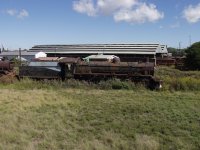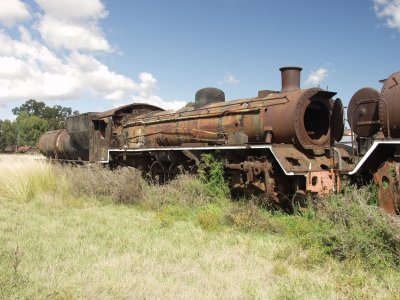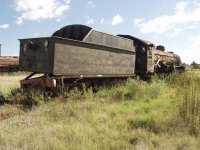Please click on the images to see a larger image and a brief description.
Introduction:
The town of Klerksdorp is located on the Johannesburg-Cape Town railway main line and it is also on the N12
auto route as the road parallels the railway.
Once near the town of Klerksdorp, the easiest way to find the railway station is to visually locate and then set a course toward the large silos.
During the 1980's I remember the electric multiple unit (e.m.u) train sets from Johannesburg would reach this far south. This was the southern most terminus for the e.m.u. fleet on this railway line. Unfortunately, the e.m.u services have been discontinued and now only the long distance passenger trains provide a rail passenger
service for Klerksdorp.
I can recall that during my visits in the mid 1980's, the Klerksdorp steam locomotive shop was performing the light overhauls to their allocated steam fleet. Therefore, there always seemed to be the smell of new paint and degreasing in the air. Nowadays, this is of course only a memory. However, many of the Klerksdorp steam fleet are still nearby in the grass lot located only a stone throw east of the shed building.
I hope the following images prove informative. I could not stay for too long a time as my goal was to reach Beaconsfield by nightfall and I still wanted to stop by Warrenton. Therefore, next time I visit Klerksdorp I will allocate a few more hours into the schedule so I may take 'better' images.
|
To reach the Klerksdorp locomotive shed from the passenger station is really simple. Just get past the gates at the passenger station and follow the passenger platforms southward until you see the concrete walkway that crosses all the tracks. There, in view and across the multiple tracks, is the shed.
On the way across, one can grab a few quick snaps of the through trains performing
crew changes. During my visit, only one northbound mineral train come through.
The first image of three, shows a crew change taking place for the mineral train. Then, in the second image, located at the north side of the loco shed, is a real gem, a Class 5E1 electric. Unfortunately, its road number is a freaky 666.
The final and third image shows the diesel lineup at the same location. I didn't venture to the south side of the shed as all that would be in the shadows.
|
|
While standing on the tender of 19D #3335, I took these snaps while viewing southward. The electrified line to the left is a line to the goods yard located just south of the locomotive shed. This grass lot, even during the 1980's, was occupied with discarded locomotives. I have taken a panoramic of steam locomotives in the grass lot as viewed left to right.
|
|
Here is a strange case. A discarded locomotive with what appears to be a newly painted tender. Perhaps the steam activities, operations and maintenance, were both abruptly ended instead of slowly being phased out. My best guess, and mind you this is only a guess, is that the steam activity ceased here some time in the year 1992. If I can ever nail down a solid date, I will update this page.
|

|
|
|
|
|
19D #3335.
Way back in Dec 1985, I hired on as a pre-university staff technician at the Vaal Reefs Mining & Exploration Company, Ltd. mining operation in Vaal Reefs. Not far from Klerksdorp. The mine hired steam locomotives from the South African Railways that were based and maintained at the Klerksdorp shed. That is, the mine used the locomotives on the mine property. But the SAR would get the locos back for the maintenance (boiler washing, etc.) and to perform any repairs.
My first assignment was as a student fireman (stoker) and this 19D #3335 was my first locomotive.
On that first evening the regular fireman booked off. As I was on the list as a learner, no replacement was called. The mine shunts were short, and in reality, the drivers had done without firemen before. Therefore, this was a good way to learn the locomotives, in a heavy shunting environment.
The evening was progressing rather well until both of the water injectors (fireman and driver side) did not want to pick up water. The water was about 1/2" in the sight glass and I was getting mighty worried. We stopped the train on the dumper and while the ground crews dumped the ore the steam pressure built up sufficiently enough to allow the driver's injector to kick in. Phew, that was close!
The issue at hand was worn injectors and a novice fireman. The driver made notice to me that locomotives on hire to the mines were not maintained to standards as on the SAR and that I should not let the boiler pressure drop so low again. Lesson well learned.
So dear loco, long time no see.
I believe Vaal Reefs Mining & Exploration dieselized around the year 1992.
|

|
|
|
Perhaps a victim of Vaal Reefs is this 19D #2755. I recall that during early 1986 one of the Vaal Reef mine shunts derailed while
traveling tender first (box tender such as shown here) into the points of a turnout. The result was a steam locomotive and tender that required a heavy lift back onto the rails. What was so interesting about the event was that the loco and tender had no
apparent damage immediately after the derailment. The real damage occurred when the mine's mechanical forces put the loco and tender back on the rails! As bad as that seems, it wasn't. From the mine's point of view, the entire west end of the private railway was clogged by the derailed loco and tender, and they had the fear of God in them to get the line open within hours. So, they did what they had to do, and fast.
Normally, this kind of damage is far from career ending. But steam was on its way out, even back in 1986, so this engine must have gone back to Klerksdorp to act as a source for spare parts.
If I can ever find my photos and the report of that accident, I will be able to then confirm or deny if this was indeed that very locomotive. However, this loco fits my memory of the event very well.
|

| 
|
|
|
|
These two images are really only useful for navigating what once was.
I am standing on the foundation of what was a floodlight for this section of the shed. Therefore, as can be seen, it was located directly across from the silos.
Such little bits of info may help someone if they try to take a 1980's vintage photograph and compare
it to what exists today.
|
|
There are quite a few locomotives in the grass lot. How many, I never took a tally. But here is a quick snap of 15CA #2835.
|
|
Moving on now, in the direction of the silos, I found the concrete walk bridge
that spans the former coaling pit.
From what I recall, the locos coaled on the left hand side road, while ashes were handled down the slide pan into gondola wagons spotted on the right hand side road. Notice all the ash deposits on the right hand side of the image.
|
|
Walking along the west retaining wall and out toward the north end of the coaling pit. These snaps show the general area.
|
|
Continuing to walk northward along the west side of the pit. The remains of the coaling stage foundation for the trestle is visible.
I took three shots, from left to right. Notice that the class 36 diesel is in the area.
|
|
Walking just a bit further north allowed for this image of the water tower.
|
|
Now that the class 36 diesel is no longer moving in the area, I decided to walk out into the yard and take a few snaps of the electrics. Here we have our subject, a DC electric class 6E1 #1236.
|
|
Carefully, I ventured out into the yard to take these images. The electrics to the left, as seen in the first image, are the lineup that contains 6E1.1236. I then walked up toward the concrete walkway that leads from the passenger station platform to the loco shed. Notice that the mineral train, lead by 6E1.1475, has departed.
|
|
The Klerksdorp station is nothing like it was in the 80's. No more hustle and bustle of the suburban electrics. No more steam shunts.
The pedestrian footbridge located on the north side of the station has been blocked off from the public road located to the east of the grass lot.
Here are two images of the station, taken from up on the pedestrian footbridge. The view is facing southward.
|
|